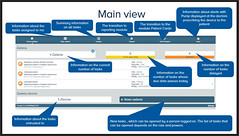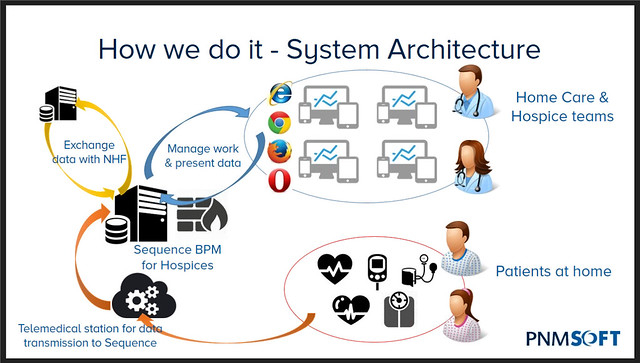I listened in on a webinar by Vasileios Kospanos of PNMSoft today about business process management (BPM) and the internet of things (IoT). They started with some basic definitions and origins of IoT – I had no idea that the term was coined back in 1999, which is about the same time that the term BPM came into use – as a part of controls engineering that relied on a lot of smart devices and sensors producing data and responding to remote commands. There are some great examples of IoT in use, including environmental monitoring, manufacturing, energy management, and medical systems, in addition to the more well-known consumerized applications such as home automation and smart cars. Gartner claims that there will be 26B devices on the internet by 2020, which is probably not a bad estimate (and is also driving the new IP6 addressing standards).
 Dominik Mazur from Amedar Consulting Group (a Polish business and technology consulting firm) joined to discuss a case study from one of their healthcare projects, helping to improve the flow of medical information and operational flow that included home care and hospices – parts of the medical system that are often orphaned from an information gathering standpoint – tied into their National Health Fund systems. This included integrating the information from various devices used to measure the patients’ vital statistics, and supported processes for admission and discharge from medical care facilities. The six types of special purpose devices communicate over mobile networks, and can store the data for later forwarding if there is no signal at the point of collection. Doctors and other health care professionals can view the data and participate in remote diagnosis activities or schedule patient visits.
Dominik Mazur from Amedar Consulting Group (a Polish business and technology consulting firm) joined to discuss a case study from one of their healthcare projects, helping to improve the flow of medical information and operational flow that included home care and hospices – parts of the medical system that are often orphaned from an information gathering standpoint – tied into their National Health Fund systems. This included integrating the information from various devices used to measure the patients’ vital statistics, and supported processes for admission and discharge from medical care facilities. The six types of special purpose devices communicate over mobile networks, and can store the data for later forwarding if there is no signal at the point of collection. Doctors and other health care professionals can view the data and participate in remote diagnosis activities or schedule patient visits.
 Mazur showed the screens used by healthcare providers (with English annotations, since their system is in Polish) as well as some of the underlying architecture and process models implemented in PNMSoft, such as the admitting interview and specialist referrals process for patients, as well as coordination of physician and specialist visits, plus home medical equipment rental and even remote configuration through remote monitoring capabilities. He also showed a live demo of the system, highlighting features such as alarms that appear when patient data falls outside of normal boundaries; they are integrating third-party and open-source tools such as Google for charting data directly into their dashboards. He also discussed how other devices can be paired to the systems using Bluetooth; I assume that this means that a consumer healthcare device could be used as an auxiliary measurement device, although manufacturers of these devices are quick to point out that they are not certified healthcare devices in order to absolve themselves of responsibility for bad data.
Mazur showed the screens used by healthcare providers (with English annotations, since their system is in Polish) as well as some of the underlying architecture and process models implemented in PNMSoft, such as the admitting interview and specialist referrals process for patients, as well as coordination of physician and specialist visits, plus home medical equipment rental and even remote configuration through remote monitoring capabilities. He also showed a live demo of the system, highlighting features such as alarms that appear when patient data falls outside of normal boundaries; they are integrating third-party and open-source tools such as Google for charting data directly into their dashboards. He also discussed how other devices can be paired to the systems using Bluetooth; I assume that this means that a consumer healthcare device could be used as an auxiliary measurement device, although manufacturers of these devices are quick to point out that they are not certified healthcare devices in order to absolve themselves of responsibility for bad data.
He wrapped up with lessons that they learned from the project, which sound much like many other BPM projects: model-driven Agile development (using PNMSoft, in their case), and work closely with key stakeholders. However, the IoT aspect adds complexiy, and they learned some key lessons around that, too: start device integration sooner, and allow 20-30% of time for testing. They developed a list of best practices for similar projects, including extending business applications to mobile devices, and working in parallel on applications, device integration and reporting.
We wrapped up with an audience Q&A, although there were many more questions than we had time for. One of the more interesting ones was around automated decisioning: they are not doing any of that now, just alerting that allows people to make decisions or kick off processes, but this work lays the foundation for learning what can be automated without risk in the future. Both patients and healthcare providers are accepting the new technology, and the healthcare providers in particular find that it is making their processes more efficient (reducing administration) and transparent.
Great webinar. It will be available on demand from the resources section on PNMSoft’s website within a few days.
Update: PNMSoft published the recording on their YouTube channel within a couple of hours. No registration required!

